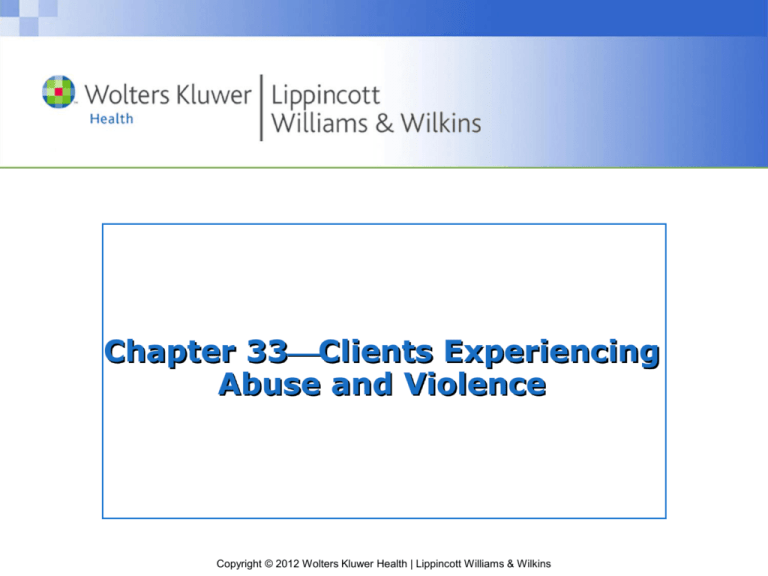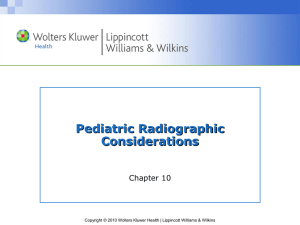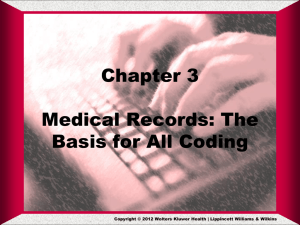
Chapter 33Clients Experiencing
Abuse and Violence
Copyright © 2012 Wolters Kluwer Health | Lippincott Williams & Wilkins
Please, Mom and Dad
My hands are small—I don’t mean to spill my
milk.
My legs are short—please slow down so I can
keep up with you.
Don’t slap my hands when I touch something
bright and pretty—I don’t understand.
Please look at me when I talk to you—it lets
me know you are really listening.
My feelings are tender—don’t nag me all
day—let me make mistakes without feeling
stupid.
Copyright © 2012 Wolters Kluwer Health | Lippincott Williams & Wilkins
Don’t expect the bed I make or the picture I
draw to be perfect—just love me for trying.
Remember I am a child not a small adult—
sometimes I don’t understand what you are
saying.
I love you so much. Please love me just for
being me—not just for the things I can do.
—J. Richardson and J. Richardson
(Poster Funded by Health and Rehabilitative
Services, State of Florida)
Copyright © 2012 Wolters Kluwer Health | Lippincott Williams & Wilkins
Learning Objectives
After studying this chapter, you should be able to
• Identify risk factors that create an environment for child
abuse
• Differentiate between child abuse and child neglect, and
cite an example of each
• Recognize at least five common physical findings
indicating physical abuse of a child
• Differentiate among the terms sexual harassment, sexual
assault, rape, and statutory rape
• Articulate the dynamics of rape trauma syndrome
• Illustrate how elderly persons are abused
Copyright © 2012 Wolters Kluwer Health | Lippincott Williams & Wilkins
Learning Objectives (cont.)
• Explain at least four causative factors related to
domestic violence
• Discuss the dynamics of intimate partner or spousal
abuse
• Construct a profile of an individual who may become
violent in the work setting
• Describe the emotional and behavioral reactions of
the following victims of physical abuse or domestic
violence: children, women, men, and the elderly
• Develop an assessment tool for the following clients:
a victim of child abuse, an elderly victim of domestic
violence, and a teenaged victim of rape
Copyright © 2012 Wolters Kluwer Health | Lippincott Williams & Wilkins
Elements of Abuse
•
•
The abuser
–
Individuals who grew up in an abusive family
–
Low self-concept, immature, fear authority, lack skills to
meet emotional needs, believe in harsh physical discipline,
poor impulse control, lack of parenting or relationship skills,
often use alcohol or other substances to cope with stress
The abused
–
•
Pattern of learned helplessness, low self-esteem, and shame
and feelings of dependence, isolation, guilt, and entrapment
A crisis
–
The precipitating event that sets an abusive person into
action
Copyright © 2012 Wolters Kluwer Health | Lippincott Williams & Wilkins
Child Abuse
• Etiology of child abuse
• Characteristics of potentially abusive parents
• Characteristics of an abused child
• Classifications of child abuse
– Physical abuse of a child
• Physical indicators
• Munchausen’s syndrome by proxy
• Shaken baby syndrome
• Behavioral and environmental indicators
Copyright © 2012 Wolters Kluwer Health | Lippincott Williams & Wilkins
Examples of Child Abuse
Copyright © 2012 Wolters Kluwer Health | Lippincott Williams & Wilkins
Child Abuse (cont.)
– Child neglect
• Physical indicators
• Behavioral and environmental indicators
– Emotional abuse or neglect
• Behavioral and environmental indicators
– Child sexual abuse
• Classifications of child sexual abuse
• Terminology of child sexual abuse
– Child abduction
Copyright © 2012 Wolters Kluwer Health | Lippincott Williams & Wilkins
Domestic or Intimate Partner Violence
• Groups at risk
• Epidemiology
• Factors contributing to
domestic violence
• Profiles of the abuser and
the abused
• Forms of domestic
violence
Copyright © 2012 Wolters Kluwer Health | Lippincott Williams & Wilkins
Domestic or Intimate Partner Violence
(cont.)
• Dynamics of domestic
violence
– Tension-building
phase
– Acute battering
phase
– Loving phase
• Barriers to leaving a
violent relationship
– Lack of resources
– Lack of institutional
responses
– Traditional ideology
Copyright © 2012 Wolters Kluwer Health | Lippincott Williams & Wilkins
Adult Sexual Abuse
• Sexual harassment, stalking, and sexual coercion
• Rape
– Essential elements of rape
– Rape victim profile
– Motives for rape
– Subclassifications of rape
– Emotional reactions to rape
• Long-term reactions to rape
• Adult survivors of childhood sexual abuse
Copyright © 2012 Wolters Kluwer Health | Lippincott Williams & Wilkins
Elder Abuse
• Major types of elder abuse
– Physical abuse
– Sexual abuse
– Emotional or psychological abuse
– Abandonment
– Financial or material exploitation
– Self-neglect
• Etiology
• Emotional responses to elder abuse
Copyright © 2012 Wolters Kluwer Health | Lippincott Williams & Wilkins
Violence
• Youth violence
– Etiology
– Emotional responses of youth violence victims
• Workplace violence
– Predictors of workplace violence
– Classification of workplace violence incidents
– Emotional responses of workplace violence victims
• Hate crimes
Copyright © 2012 Wolters Kluwer Health | Lippincott Williams & Wilkins
The Nursing Process
• Assessment
• Nursing diagnoses
• Outcome identification
• Planning interventions
• Implementation
• Evaluation
Copyright © 2012 Wolters Kluwer Health | Lippincott Williams & Wilkins
Assessment
• Assessment of abuse in children and adolescents
– Biopsychosocial data
– Documentation of the assessment
• Assessment of adult victims of physical abuse or
violence
– Biopsychosocial data
– Assessment tools
– Documentation of data
Copyright © 2012 Wolters Kluwer Health | Lippincott Williams & Wilkins
Assessment (cont.)
• Assessment of victims of sexual abuse or rape
– Guidelines for data collection
– Medical data
– Behavioral and emotional responses
– Collection and documentation of physical evidence
• Transcultural considerations
Copyright © 2012 Wolters Kluwer Health | Lippincott Williams & Wilkins
Nursing Diagnoses
• Anxiety
• Impaired verbal communication
• Ineffective denial
• Disabled family coping
• Interrupted family processes
• Fear
• Rape trauma syndrome
• Risk for violence
Copyright © 2012 Wolters Kluwer Health | Lippincott Williams & Wilkins
Outcome Identification
Outcomes focus on the following:
• Reducing anxiety, fear, pain, and the potential for injury
or violence
• Improving communication, coping, self-esteem, or selfconcept
• Identifying members of support system(s) and the
appropriate use of them
• Assisting the victim in returning to a precrisis level of
functioning
Copyright © 2012 Wolters Kluwer Health | Lippincott Williams & Wilkins
Planning Interventions
Immediate care should focus on the following:
• Meeting the client’s physical and emotional needs
• Promoting homeostasis and comfort
• Reducing fear
Copyright © 2012 Wolters Kluwer Health | Lippincott Williams & Wilkins
Implementation
• Interventions for child abuse:
– Multidisciplinary approach
– Behavioral interventions
– Continuum of care
– Prevention of child abuse and neglect
Copyright © 2012 Wolters Kluwer Health | Lippincott Williams & Wilkins
Implementation (cont.)
• Interventions for victims of physical abuse and violence:
– Safe environment
– Supportive therapies
– Continuum of care
Copyright © 2012 Wolters Kluwer Health | Lippincott Williams & Wilkins
Implementation (cont.)
• Interventions for victims of sexual abuse:
– Crisis intervention
– Continuum of care
– Care of elderly survivors of sexual abuse
Copyright © 2012 Wolters Kluwer Health | Lippincott Williams & Wilkins
Implementation (cont.)
• Interventions for victims of youth or workplace violence
and hate crimes:
– Developing awareness
– Trauma/crisis counseling or critical-incident stress
debriefing
– Providing assistance
Copyright © 2012 Wolters Kluwer Health | Lippincott Williams & Wilkins
Evaluation
Evaluation should focus on the following:
• The client’s emotional and physical well-being
• Efficacy of the medication
• Effectiveness of interventions
• Client progress
Copyright © 2012 Wolters Kluwer Health | Lippincott Williams & Wilkins
Key Terms
• Abduction
• Emotional neglect
• Abuse
• Family violence
• Attempted rape
• Hate crime
• Child abuse
• Incest
• Discipline
• Intimate partner
violence
• Domestic violence
• Emotional abuse
• Munchausen’s syndrome
by proxy
Copyright © 2012 Wolters Kluwer Health | Lippincott Williams & Wilkins
Key Terms (cont.)
• Neglect
• Shaken baby syndrome
• Rape
• Silent rape syndrome
• Rape trauma syndrome
• Sodomy
• Sexual abuse
• Stalking
• Sexual coercion
• Statutory rape
• Sexual harassment
• Violence
• Sexual misuse of a child
• Workplace violence
Copyright © 2012 Wolters Kluwer Health | Lippincott Williams & Wilkins
Reflection
Reflect on the chapter-opening quote by
Richardson and Richardson. In your own words,
interpret the message that the authors are
relating.
• In what situations would it be
appropriate to use this poster?
• Explain the rationale for your
answer.
Copyright © 2012 Wolters Kluwer Health | Lippincott Williams & Wilkins
?







